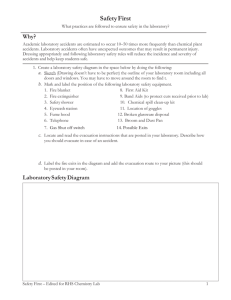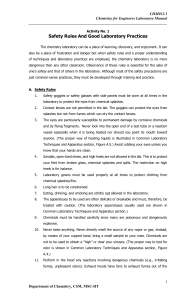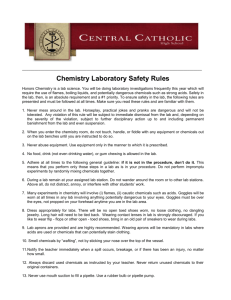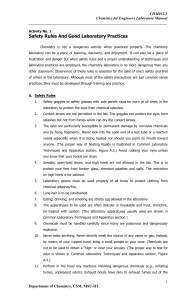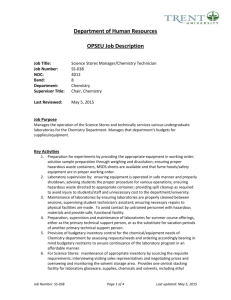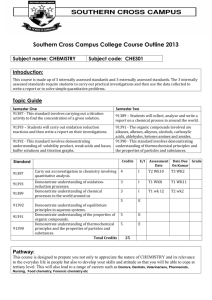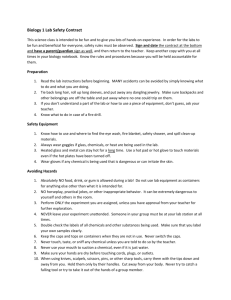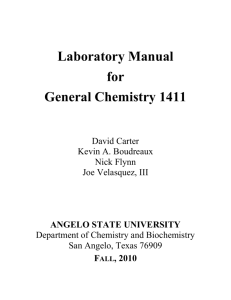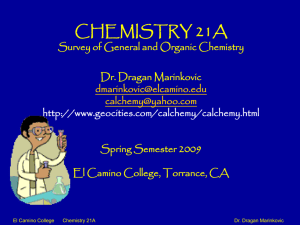File - Biplob`s School of Chemistry
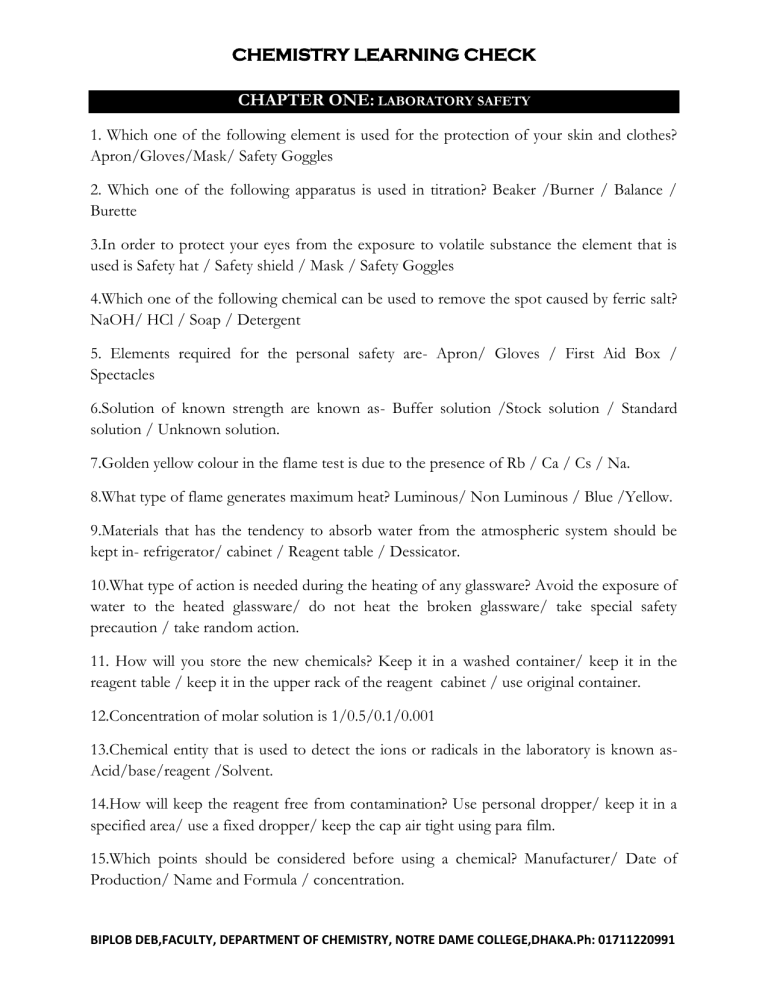
CHEMISTRY LEARNING CHECK
CHAPTER ONE:
LABORATORY SAFETY
1. Which one of the following element is used for the protection of your skin and clothes?
Apron/Gloves/Mask/ Safety Goggles
2. Which one of the following apparatus is used in titration? Beaker /Burner / Balance /
Burette
3.In order to protect your eyes from the exposure to volatile substance the element that is used is Safety hat / Safety shield / Mask / Safety Goggles
4.Which one of the following chemical can be used to remove the spot caused by ferric salt?
NaOH/ HCl / Soap / Detergent
5. Elements required for the personal safety are- Apron/ Gloves / First Aid Box /
Spectacles
6.Solution of known strength are known as- Buffer solution /Stock solution / Standard solution / Unknown solution.
7.Golden yellow colour in the flame test is due to the presence of Rb / Ca / Cs / Na.
8.What type of flame generates maximum heat? Luminous/ Non Luminous / Blue /Yellow.
9.Materials that has the tendency to absorb water from the atmospheric system should be kept in- refrigerator/ cabinet / Reagent table / Dessicator.
10.What type of action is needed during the heating of any glassware? Avoid the exposure of water to the heated glassware/ do not heat the broken glassware/ take special safety precaution / take random action.
11. How will you store the new chemicals? Keep it in a washed container/ keep it in the reagent table / keep it in the upper rack of the reagent cabinet / use original container.
12.Concentration of molar solution is 1/0.5/0.1/0.001
13.Chemical entity that is used to detect the ions or radicals in the laboratory is known as-
Acid/base/reagent /Solvent.
14.How will keep the reagent free from contamination? Use personal dropper/ keep it in a specified area/ use a fixed dropper/ keep the cap air tight using para film.
15.Which points should be considered before using a chemical? Manufacturer/ Date of
Production/ Name and Formula / concentration.
BIPLOB DEB,FACULTY, DEPARTMENT OF CHEMISTRY, NOTRE DAME COLLEGE,DHAKA.Ph: 01711220991
CHEMISTRY LEARNING CHECK
16.What type of precaution can be taken for the protection of the apparatus? Keep it in its original place after use/ Make it clean after use / Do not touch the hot glassware / Use broken beaker.
17.How will you minimize the risk of a chemistry laboratory? Do not keep any expired chemicals/ Keep the solid waste in a specific dustbin /Pour the chemicals in the drain after use/ Use safe disposal practice.
18. What type of pollution may arise if you discard your chemicals directly in the drainage system? Air / Water /Soil / Sound.
19.What amount of NaOH will be needed to produce 100 mL 0.1M solution? 1/ 0.5 /0.4
/0.1g
20. Semi micro analysis hold the analyte in the scale of 1g / 0.01g / 0.001g/ 0.0001g
21.If the weight of rider is 1mg and if the partion is 100 then the rider constant will be-
0.1/0.01/0.001/0.0001
22.What amount of solution should be taken from 0.5M HCl solution to make it 100 mL
0.2M?20/40/60/80
23. First aid box contains-Mineral water / dettol / distilled water / antiseptic cream.
24. The chemical entity that is used in the titration process to change the colour at the end point is known as
Acid / Base / Indicator/ Oxidant.
25.What will you do after the experiment? Safe disposal / Pour the chemicals in the drain /
Wash the apparatus / Discard the materials in the water body .
26.How will you perform the experiments that generates smoke? Open laboratory system/
Near the water bath / Close to the refrigerator / In a fume compartment.
27.Which type of equipment requires special attention? Sharp edged / Glassware / Plastic /
Metallic.
28.Which one of the following equipment is needed to take the solution from the container during the titration? Burette/ Pipette/ Measuring cylinder / test tube.
29. What amount of 0.1M NaOH will be needed to neutralize 100 mL 0.1M HCL solution?
20/50/100/200.
BIPLOB DEB,FACULTY, DEPARTMENT OF CHEMISTRY, NOTRE DAME COLLEGE,DHAKA.Ph: 01711220991
CHEMISTRY LEARNING CHECK
30.Which one of the following system is used in the accident? Calling Bell/ refrigerator/ Fire
Alarm / eye Washer.
31.What will you do if your skin is exposed to acid? Wash it with water rapidly/ contact with the doctor/ use base / make noise in the laboratory.
32.How will you reduce the harmful impact on environment? Recycle/ Restore/
Reintroduce/ Refining.
33.Blue litmus turns red because of acid / base / water / oxidant.
34.Chemicals having low bp is known as volatile/ sublimate/ amorphous/anhydrous.
35.What is the goal of optimum use of chemicals? Right form of experiment / safety / environmental protection / Minimization of laboratory risk.
36.What type of balance is more feasible? Analog/ 2 digit digital / 4 digit digital / analytical balance.
37.Which option will be followed for the safe disposal of acid? Safe storage / Neutralization
/ Dilution / Direct throwing in the soil.
38.Safety goggles is used when- fumes will be generated / Conc. Acids are used / Volatile substances are used/ making a solution by dissolving solute of solid state.
39.What do mean by decimolar solution? 1M/0.5M /0.1M /0.001M.
40.What amount of water is needed to make 250 cc sulphuric acid solution of 0.5m from 1M solution?125/250/500/600mL
BIPLOB DEB,FACULTY, DEPARTMENT OF CHEMISTRY, NOTRE DAME COLLEGE,DHAKA.Ph: 01711220991
